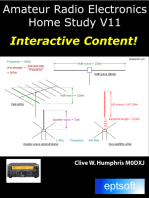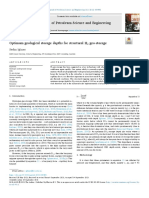RF Oscillator and Its Neeeds
RF Oscillator and Its Neeeds
Uploaded by
Arnab PalCopyright:
Available Formats
RF Oscillator and Its Neeeds
RF Oscillator and Its Neeeds
Uploaded by
Arnab PalOriginal Title
Copyright
Available Formats
Share this document
Did you find this document useful?
Is this content inappropriate?
Copyright:
Available Formats
RF Oscillator and Its Neeeds
RF Oscillator and Its Neeeds
Uploaded by
Arnab PalCopyright:
Available Formats
RF OSCILLATOR AND ITS NEEEDS:
Any communication system that transmits and receives data on a high frequency carrier needs to be able to generate the carrier, usually using an oscillator. We need to be able to design an oscillator that can produce a high-quality signal at a pre-determined frequency with little noise and low harmonics. In real receivers, the oscillator is phase and frequency locked to the incoming carrier using a carrier recovery circuit
OSCILLATOR CHARACTERISTICS:
An oscillator is a device that generates a high frequency signal with only a DC signal input. It begins oscillating due to amplification of noise or a transient signal. Oscillators consist of two major blocks: An active, nonlinear element that provides gain A frequency selective circuit (e.g. LC tank, crystal oscillator, dielectric resonator)
We design oscillators with criteria such as: frequency stability over bias and temperature variations spectral purity (low power in harmonics, and low phase noise) power consumption area consumption
Phase noise and its effect in a communication system
Oscillators produce generally produce fairly sinusoidal signals, but noise inside the oscillator (1/f noise, thermal noise, shot noise, etc.) leads to variations in the generated signal. In the time domain this leads to "jitter" at the fundamental frequency, i.e. the period of the signal differs very slightly from one time to another. In the frequency domain, this is called phase noise, and leads to a rapidly decreasing power around the desired frequency. ELEC-853 (Silicon Integrated Circuits) has more information about oscillator phase noise. This phase noise has a significant effect on the feedthrough of interfering signals. If an undesired signal is closely spaced in frequency to the desired signal, both signals will be mixed by the oscillator signal. Since the oscillator has a finite power at small frequency offsets from the central frequency, it will result in a "spreading" of both the desired signal and the interfering signal. This will lead to the interfering signal overlapping the desired signal. If the interfering signal is larger than the desired, this can cause significant problems. For this reason, oscillators with low phase noise are required for communication systems.
Feedback Oscillators
The simplest way to create an oscillator is to use an explicit frequency-selective feedback network with a gain element (transistor). This is often an LC tank, as we will examine here, but dielectric resonators or transmission lines can also be used. These last two offer lower noise but are physically larger. Feedback oscillators are becoming more popular at very high frequencies ( > 50 GHz). A amplifier with appropriate feedback can be designed as an oscillator. For the system on the right the output voltage is
Vo() = AVi() + H()AVo or rearranging to solve for Vo
We will have a non-zero output (i.e. oscillaton) with a zero input when 1 AH() = 0
PREAMPLIFIER
A preamplifier (preamp) is an electronic amplifier that prepares a small electrical signal for further amplification or processing. A preamplifier is often placed close to the sensor to reduce the effects of noise and interference. It is used to boost the signal strength to drive the cable to the main instrument without significantly degrading the signal-to-noise ratio (SNR). The noise performance of a preamplifier is critical; according to Friis's formula, when the gain of the preamplifier is high, the SNR of the final signal is determined by the SNR of the input signal and the noise figure of the preamplifier.
In a home audio system, the term 'preamplifier' may sometimes be used to describe equipment which merely switches between different line level sources and applies a volume control, so that no actual amplification may be involved. In an audio system, the second amplifier is typically apower amplifier (power amp). The preamplifier provides voltage gain (e.g. from 10 millivolts to 1 volt) but no significant current gain. The power amplifier provides the higher current necessary to driveloudspeakers. Preamplifiers may be: incorporated into the housing or chassis of the amplifier they feed in a separate housing mounted within or near the signal source, such as a turntable, microphone or musical instrument.
Examples
The integrated preamplifier in a foil electret microphone. The first stages of an instrument amplifier. A stand-alone unit for use in live music and recording studio applications. As part of a stand-alone channel strip or channel strip built into an audio mixing desk. A masthead amplifier used with television receiver antenna or a satellite receiver dish. The circuit inside of a hard drive connected to the magnetic heads or the circuit inside of CD/DVD drive which connects to thephotodiodes. A switched capacitor circuit used to null the effects of mismatch offset in most CMOS comparatorbased flash analog-to-digital converters
Matching the Preamplifier to the Detector and the Application
The primary function of a preamplifier is to extract the signal from the detector without significantly degrading the intrinsic signal-tonoise ratio. Therefore, the preamplifier is located as close as possible to the detector, and the input circuits are designed to match the characteristics of the detector. Different pulse processing techniques are typically employed, depending on whether the arrival time or the amplitude (energy) of the detected event must be measured. Pulse shaping for either application is normally implemented in a subsequent module. This module can be located at some distance from the preamplifier, provided that the signal fidelity is not degraded due to the length of the interconnecting coaxial cable.
Preamplifier Types
Three basic types of preamplifiers are available: the current-sensitive preamplifier, the parasiticcapacitance preamplifier, and thecharge-sensitive preamplifier. The following paragraphs describe their functions and primary performance characteristics.
Current-Sensitive Preamplifiers
Several detector types, such as photomultiplier tubes and microchannel plates, generate a moderately large and fast-rising output signal through a high output impedance. Pulse processing for timing or counting with these detectors can be rather simple. Aproperlyterminated 50-coaxial cable is attached to the detector output, so that the current pulse from the detector develops the desired voltage pulse across the 50-load presented by the cable. For scintillators mounted on 14-stage photomultiplier tubes, this voltage signal is usually large enough to drive the input of a fast discriminator without further amplification. For single-photon counting, 10stage photomultiplier tubes, or microchannel plate PMTs, additional amplification is needed between the detector and the discriminator, and this is the function of the current-sensitive preamplifier.
Charge-Sensitive Preamplifiers
These preamplifiers are preferred for most energy spectroscopy applications. The signal from a semiconductor detector or ion chamber is a quantity of charge delivered as a current pulse lasting from 109 to 105 s, depending on the type of detector and its size. For most applications the parameters of interest are the quantity of charge and/or the time of occurrence of an event. A chargesensitive preamplifier (Fig. 3) can deliver either or both. Because it integrates the charge on the feedback capacitor, its gain is not sensitive to a change in detector capacitance, and in the ideal case, the rise time of the output pulse is equal to the detector current pulse width.
Parasitic-Capacitance Preamplifiers
Photomultiplier tubes, electron multipliers, microchannel plates, and microchannel plate PMTs produce moderately large output signals with very fast rise times. Parasitic-capacitance preamplifiers have a high input impedance (~5 M). Hence, the current pulse generated by the detector is integrated on the combined parasitic capacitance present at the detector output and the preamplifier input. This combined capacitance is typically 10 to 50 pF. The resulting signal is a voltage pulse having an amplitude proportional to the total charge in the detector pulse, and a rise time equal to the duration of the detector current pulse. A resistor connected in parallel with the input capacitance causes an exponential decay of the pulse with a time constant ~50 s. An amplifier having a high input impedance and unity gain is included as a buffer to drive the low impedance of a coaxial cable at the output. The 93-resistor in series with the output absorbs reflected pulses in long cables by terminating the cable in its characteristic impedance.
You might also like
- Ucsb Admissions Decision LetterDocument1 pageUcsb Admissions Decision Letterapi-330184191No ratings yet
- Toyota and Chassis Co - Case StudyDocument3 pagesToyota and Chassis Co - Case StudyShajara Whave UsonNo ratings yet
- Solas - Jamie Duffy Sheet Music For Piano (Solo)Document1 pageSolas - Jamie Duffy Sheet Music For Piano (Solo)Élie DolbecNo ratings yet
- BT 4 HWDocument9 pagesBT 4 HWNerinel CoronadoNo ratings yet
- CAE ATPL 4 PowerplantDocument460 pagesCAE ATPL 4 PowerplantAŞKIN FIRAT100% (2)
- AM ReceiverDocument8 pagesAM ReceiverSean Matthew L. OcampoNo ratings yet
- Mini Audio AmplifierDocument32 pagesMini Audio AmplifierSanjivee Sachin83% (6)
- Accutronics Reverb Part # Reference and Application NotesDocument6 pagesAccutronics Reverb Part # Reference and Application Notesrythmaccount100% (1)
- Radio Communication Jto Lice Study Material SampleDocument17 pagesRadio Communication Jto Lice Study Material SampleArghya PalNo ratings yet
- Iodine ValueDocument4 pagesIodine ValueRobert Gilmore100% (4)
- Amateur Radio Electronics on Your MobileFrom EverandAmateur Radio Electronics on Your MobileRating: 5 out of 5 stars5/5 (1)
- Ant Amp 1Document37 pagesAnt Amp 1moorche tabriziNo ratings yet
- Function: Gain BandwidthDocument3 pagesFunction: Gain Bandwidthtarun aroraNo ratings yet
- CHAPTER 8 Radio TransmittersDocument5 pagesCHAPTER 8 Radio TransmittersPatrick GarciaNo ratings yet
- 2012IR Audio LinkDocument5 pages2012IR Audio LinkAnkush SilhiNo ratings yet
- Electrical Engineering DepartmentDocument5 pagesElectrical Engineering DepartmentAlyssa Ashley RazoNo ratings yet
- DcomunDocument11 pagesDcomunzubair tahirNo ratings yet
- Jenis-Jenis Pre-AmpDocument6 pagesJenis-Jenis Pre-AmpFyndi Aw AwNo ratings yet
- AnalogElectronics - TH 0 AmpDocument12 pagesAnalogElectronics - TH 0 AmpAlbert GenceNo ratings yet
- Electronics and Communication Lab Manual PDFDocument41 pagesElectronics and Communication Lab Manual PDFtester100% (1)
- Principles of Electronic Communication Systems: Second EditionDocument56 pagesPrinciples of Electronic Communication Systems: Second EditionengaydiNo ratings yet
- FM TransmitterDocument5 pagesFM TransmitterLiaqat Hussain BhattiNo ratings yet
- Section-A Classification of Amplifiers: Ideal AmplifierDocument6 pagesSection-A Classification of Amplifiers: Ideal Amplifiergoyalpuneet007No ratings yet
- Laser Communication: Mini Project ReportDocument15 pagesLaser Communication: Mini Project ReportPrasannaKumarReddyKaturuNo ratings yet
- The Phase Sensitive (Lock-In) DetectorDocument21 pagesThe Phase Sensitive (Lock-In) DetectorBert ColijnNo ratings yet
- Stereo Toner Control CircuitDocument9 pagesStereo Toner Control Circuitsyed_hafeez_2No ratings yet
- Design ECG AmplifierDocument9 pagesDesign ECG Amplifierm_wssNo ratings yet
- OC - UNIT 4notesDocument42 pagesOC - UNIT 4notesAmit SivaNo ratings yet
- Electronics Lab Project: 4 Input Universal Amplifier With 6-Octave Tone Enhancer (Graphic Equalizer)Document26 pagesElectronics Lab Project: 4 Input Universal Amplifier With 6-Octave Tone Enhancer (Graphic Equalizer)kenechiNo ratings yet
- تقرير اتصالات 1Document14 pagesتقرير اتصالات 1rmnyrmny07No ratings yet
- Tuned Amplifiers Unit 3Document15 pagesTuned Amplifiers Unit 3rageroshan933No ratings yet
- Oscillators: IntroductionDocument9 pagesOscillators: IntroductionCherryl Mae AlmojuelaNo ratings yet
- Tutorial Sobre Las SondasDocument10 pagesTutorial Sobre Las SondasxaviercovisNo ratings yet
- TipfromTech DrivingLongCableLengthsDocument5 pagesTipfromTech DrivingLongCableLengthsHienNo ratings yet
- EMI-Signal GeneratorsDocument7 pagesEMI-Signal GeneratorsVineela ThonduriNo ratings yet
- Emi Unit2Document21 pagesEmi Unit2m.srinivasa raoNo ratings yet
- FEC FinalDocument32 pagesFEC FinalGemmalyn GanganNo ratings yet
- Am Transmitter: Department of Electronics Engineering School of Engineering and Architecture Saint Louis UniversityDocument19 pagesAm Transmitter: Department of Electronics Engineering School of Engineering and Architecture Saint Louis UniversitySubaru_101100% (1)
- CH 07Document51 pagesCH 07engaydiNo ratings yet
- AmplifierDocument40 pagesAmplifiertapas_kb60% (5)
- EEG-EP Basic ElectronicsDocument5 pagesEEG-EP Basic ElectronicsamurroNo ratings yet
- Experiment No. 7: Ecx-212 Analog Communication Systems LaboratoryDocument5 pagesExperiment No. 7: Ecx-212 Analog Communication Systems LaboratoryJaspreet Singh SidhuNo ratings yet
- Lab Gruppen Testing Procedure v1Document4 pagesLab Gruppen Testing Procedure v1Zoeloe_2No ratings yet
- EE-04-Electronics-Communication-NotesDocument17 pagesEE-04-Electronics-Communication-Notescarloacma473No ratings yet
- Chopper Amplifier ThesisDocument8 pagesChopper Amplifier Thesisyessicadiaznorthlasvegas100% (2)
- (DOC) Design and Construction of Wireless Public Address System Report - Esseh Andy - Academia - EduDocument22 pages(DOC) Design and Construction of Wireless Public Address System Report - Esseh Andy - Academia - EduAYEDITAN AYOMIDENo ratings yet
- Power Amplifiers: Phase Shift OscillatorDocument3 pagesPower Amplifiers: Phase Shift OscillatorAli DurazNo ratings yet
- David FinalDocument46 pagesDavid Finaljoshua olayinkaNo ratings yet
- Types of Amplifier: Journal On Electronic Circuits - Electronic Amplifier Devices and CircuitsDocument21 pagesTypes of Amplifier: Journal On Electronic Circuits - Electronic Amplifier Devices and CircuitsDany JohnyNo ratings yet
- Recording Sysytem: Sources of Noise in Low Level Recording CircuitsDocument5 pagesRecording Sysytem: Sources of Noise in Low Level Recording CircuitsPulkit SharmaNo ratings yet
- Experiment 1 AIM: To Study The Frequency Response of RC Coupled Amplifier at Low and High Frequency ApparatusDocument7 pagesExperiment 1 AIM: To Study The Frequency Response of RC Coupled Amplifier at Low and High Frequency ApparatusPratik AgrawalNo ratings yet
- Sound From UltrasoundDocument9 pagesSound From UltrasoundNakul NemaNo ratings yet
- AnalogEl 0 AmpDocument16 pagesAnalogEl 0 AmpAlbert GenceNo ratings yet
- Full Report - E1Document13 pagesFull Report - E1Naddy MohdNo ratings yet
- Original PDFDocument6 pagesOriginal PDFAlaa WahoudNo ratings yet
- Project Report #3Document9 pagesProject Report #3Muhammad AnasNo ratings yet
- Voltage Controlled Oscillator - Usage of VCO, Working and ApplicationDocument6 pagesVoltage Controlled Oscillator - Usage of VCO, Working and ApplicationseemabNo ratings yet
- Audio Amplifier PDFDocument17 pagesAudio Amplifier PDFLuiz Clemente PimentaNo ratings yet
- Chapter 3 Signal Conditioning PDFDocument13 pagesChapter 3 Signal Conditioning PDFBelayneh Tadesse50% (2)
- Amplifier Introduction in General L-1Document7 pagesAmplifier Introduction in General L-1tmya06No ratings yet
- What Is AmplifierDocument18 pagesWhat Is AmplifierEbayLunaNo ratings yet
- Electronic Circuit Analysis and DesignDocument4 pagesElectronic Circuit Analysis and DesignMarx Lennin CabalticanNo ratings yet
- Tarea ElectronicaDocument23 pagesTarea ElectronicaSebastian OrdoñezNo ratings yet
- Differential Amplifier: Emitter Followers Common Base Miller EffectDocument3 pagesDifferential Amplifier: Emitter Followers Common Base Miller EffectCarlFaustineNo ratings yet
- Crime Detection and InvestigationDocument14 pagesCrime Detection and Investigationkuya CaRloNo ratings yet
- EthicsDocument1 pageEthicsColeen GaliciaNo ratings yet
- A Case Presentation On A Mediastinal MassDocument51 pagesA Case Presentation On A Mediastinal MassJon Francis CoNo ratings yet
- Onlinebook CollectionsDocument1,061 pagesOnlinebook CollectionsMarsela TurkuNo ratings yet
- Chapter 11 The Influence of Culture On Consumer BehaviorDocument32 pagesChapter 11 The Influence of Culture On Consumer BehaviorsidhanthaNo ratings yet
- Traditional and 4a's Lesson Plan DiscussionDocument2 pagesTraditional and 4a's Lesson Plan DiscussionGeralyn Pelayo AlburoNo ratings yet
- Persiapan PPASPD PROP - PAKET 3Document9 pagesPersiapan PPASPD PROP - PAKET 3Ardana ListianaNo ratings yet
- DLP Tarucsharaleem. Beed 1b Edmath2 1Document7 pagesDLP Tarucsharaleem. Beed 1b Edmath2 1Kyla GarciaNo ratings yet
- The Last LibrarianDocument1 pageThe Last Librarianezio.auditori1122No ratings yet
- Cns InfectionsDocument141 pagesCns InfectionsReda AlyNo ratings yet
- Iso/Ts 16949 WorkshopDocument115 pagesIso/Ts 16949 WorkshopubraghuNo ratings yet
- Internship in MissionEdDocument2 pagesInternship in MissionEdschtiksNo ratings yet
- Ata 28Document27 pagesAta 28jontis jasoliyaNo ratings yet
- Cs205-E S3dec18 KtuwebDocument2 pagesCs205-E S3dec18 KtuwebVighnesh MuralyNo ratings yet
- Protein Sparing Modified Fast 09-02Document10 pagesProtein Sparing Modified Fast 09-02DiogoZanata67% (3)
- A Visit From The Goon Squad (Excerpt)Document15 pagesA Visit From The Goon Squad (Excerpt)VintageAnchor60% (5)
- Etymology Quiz: Word OriginDocument3 pagesEtymology Quiz: Word OriginLisbeth Roos RoosNo ratings yet
- 4 - How Acsl WorksDocument2 pages4 - How Acsl Worksapi-328824013No ratings yet
- CV 269Document6 pagesCV 269asanyogNo ratings yet
- Object Oriented Programming (OOP) - CS304 Power Point Slides Lecture 30Document30 pagesObject Oriented Programming (OOP) - CS304 Power Point Slides Lecture 30Sameer HaneNo ratings yet
- XxamajabDocument2 pagesXxamajabMeeNo ratings yet
- Anecdote TextDocument4 pagesAnecdote Textinsan sinurayaNo ratings yet
- Coconut Oil ProcessingDocument3 pagesCoconut Oil ProcessinglumengentiunNo ratings yet
- IGLAUER STEFAN 2022 Optimum Geological Storage Depths For Structural H2 Geo-StorageDocument4 pagesIGLAUER STEFAN 2022 Optimum Geological Storage Depths For Structural H2 Geo-Storagekennedy antwiNo ratings yet

























































































